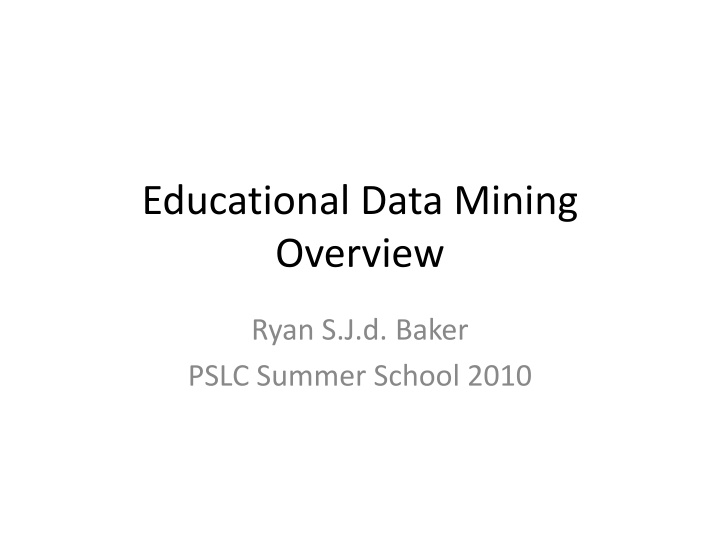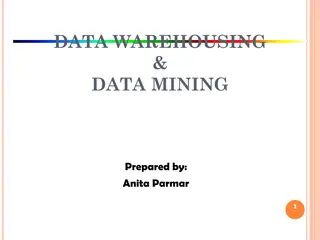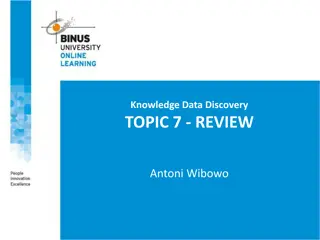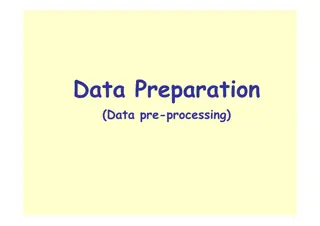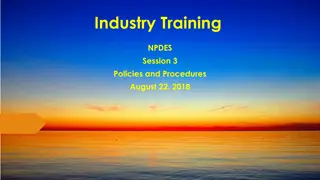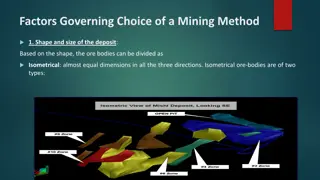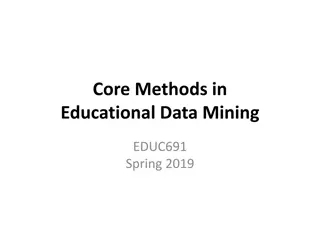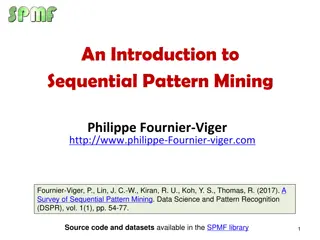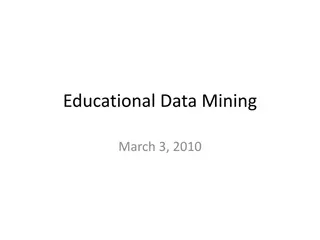Overview of Educational Data Mining
Educational Data Mining is an emerging discipline that focuses on developing methods to explore unique data from educational settings to understand students better. This includes classes of EDM methods such as prediction, clustering, relationship mining, discovery with models, and distillation of data for human judgment.
Download Presentation

Please find below an Image/Link to download the presentation.
The content on the website is provided AS IS for your information and personal use only. It may not be sold, licensed, or shared on other websites without obtaining consent from the author.If you encounter any issues during the download, it is possible that the publisher has removed the file from their server.
You are allowed to download the files provided on this website for personal or commercial use, subject to the condition that they are used lawfully. All files are the property of their respective owners.
The content on the website is provided AS IS for your information and personal use only. It may not be sold, licensed, or shared on other websites without obtaining consent from the author.
E N D
Presentation Transcript
Educational Data Mining Overview Ryan S.J.d. Baker PSLC Summer School 2010
Educational Data Mining Educational Data Mining is an emerging discipline, concerned with developing methods for exploring the unique types of data that come from educational settings, and using those methods to better understand students, and the settings which they learn in. www.educationaldatamining.org
Classes of EDM Method (Baker & Yacef, 2009) Prediction Clustering Relationship Mining Discovery with Models Distillation of Data For Human Judgment
Prediction Develop a model which can infer a single aspect of the data (predicted variable) from some combination of other aspects of the data (predictor variables) Which students are off-task? Which students will fail the class?
Clustering Find points that naturally group together, splitting full data set into set of clusters Usually used when nothing is known about the structure of the data What behaviors are prominent in domain? What are the main groups of students? Related to Principal Component Analysis Geoff Gordon s talk tomorrow
Relationship Mining Discover relationships between variables in a data set with many variables Association rule mining Correlation mining Sequential pattern mining Causal data mining
Discovery with Models Pre-existing model (developed with EDM prediction methods or clustering or knowledge engineering) Applied to data and used as a component in another analysis
Distillation of Data for Human Judgment Making complex data understandable by humans to leverage their judgment Text replays are a simple example of this
Knowledge Engineering Creating a model by hand rather than automatically fitting model In one comparison, leads to worse fit to gold- standard labels of construct of interest than data mining (Roll et al, 2005), but similar qualitative performance
EDM track schedule Tuesday 10am Educational Data Mining with DataShop (Stamper, Koedinger) Tuesday 11am Item Response Theory and Learning Factor Analysis (Koedinger) Tuesday 2:15pm Principal Component Analysis, Additive Factor Model (Gordon) Tuesday 3:15pm (optional) Hands-on Activity: Data Annotation for Classification (Baker) Hands-on Activity: Learning Curves and Logistic Regression in R (Koedinger)
EDM track schedule Wednesday 11am Bayesian Knowledge Tracing; Prediction Models (Baker) Wednesday 11:45am (optional) Hands-on activity: Prediction modeling (Baker) Wednesday 3:15pm Machine Learning and SimStudent (Matsuda)
PSLC DataShop Many large-scale datasets Tools for exploratory data analysis learning curves domain model testing Detail tomorrow morning
Microsoft Excel Excellent tool for exploratory data analysis, and for setting up simple models
Pivot Tables Who has used pivot tables before?
Pivot Tables What do they allow you to do?
Pivot Tables Facilitate aggregating data for comparison or use in further analyses
Equation Solver Allows you to fit mathematical models in Excel Let s go through a simple example together
Equation Solver: Example Let s predict correctness from pknow, using a linear regression model Using WEKA-CTA1Z04-examples.xlsx You have this data set on your flashdrive It s from the DataShop Hampton Algebra 2005- 2006 I have formatted it for this example
Under pred type =O2*$W$3+$W$2 And copy it down
Under pred type =O2*$W$3+$W$2 And copy it down Does anyone know why we use the $?
Under SR type =(G2-S2)^2 This finds the difference between the prediction (0 right now) and the correctness value (0 or 1) Squaring it is a way to both get the absolute value, and magnify larger differences; very common in statistics
To the right of weight type 1 Note that you now have a model that is identical to pknow
To the right of SSR type =SUM(T2:T2888) This is the sum of squared residuals, again a very common way of evaluating models
To the right of r type =CORREL(S2:S2888,G2:G2888) This is the correlation between the model and the variable being predicted
Now go into the Excel Equation Solver And set up this model, and press solve
We just built A very simple regression model A much simpler model than what you can build in other packages
Why is this useful? You can specify much more complex mathematical models than this And much more quickly than you can implement them in software For example, Excel is usually where I test variants on Bayesian Knowledge Tracing before implementing them in Java
Suite of visualizations Scatterplots (with or without lines) Bar graphs
Weka and RapidMiner Data mining packages Weka is the most popular, but personally I prefer RapidMiner
Weka .vs. RapidMiner Weka easier to use than RapidMiner RapidMiner significantly more powerful and flexible (from GUI, both are powerful and flexible if accessed via API)
In particular It is impossible to do key types of model validation for EDM within Weka s GUI RapidMiner can be kludged into doing so (more on this in hands-on session Wed) No tool really tailored to the needs of EDM researchers at current time
SPSS SPSS is a statistical package, and therefore can do a wide variety of statistical tests It can also do some forms of data mining, like factor analysis (a relative of clustering)
SPSS The difference between statistical packages (like SPSS) and data mining packages (like RapidMiner and Weka) is: Statistics packages are focused on finding models and relationships that are statistically significant (e.g. the data would be seen less than 5% of the time if the model were not true) Data mining packages set a lower bar are the models accurate and generalizable?
R R is an open-source competitor to SPSS More powerful and flexible than SPSS But much harder to use I find it easy to accidentally do very, very incorrect things in R Ken will demo R in a hands-on session
Matlab A powerful tool for building complex mathematical models Beck and Chang s Bayes Net Toolkit Student Modeling is built in Matlab Geoff Gordon will give a hands-on demo of Matlab
Pre-processing Tomorrow morning, John and Ken will talk about some of the great data available in DataShop
Wherever you get your data from You ll need to process it into a form that software can easily analyze, and which builds successful models
Common approach Flat data file Even if you store your data in databases, most data mining techniques require a flat data file Like the one we looked at in Excel
Some useful features to distill for educational software Type of interface widget Pknow : The probability that the student knew the skill before answering (using Bayesian Knowledge- Tracing or PFA or your favorite approach) Assessment of progress student is making towards correct answer (how many fewer constraints violated) Whether this action is the first time a student attempts a given problem step Optoprac : How many problem steps involving this skill that the student has encountered
Some useful features to distill for educational software timeSD : time taken in terms of standard deviations above (+) or below (-) average for this skill across all actions and students time3SD : sum of timeSD for the last 3 actions (or 5, or 4, etc. etc.) Action type counts or percents Total number of action so far Total number of action on this skill, divided by optoprac Number of action in last N actions Could be assessment of action (wrong, right), or type of action (help request, making hypothesis, plotting point)
